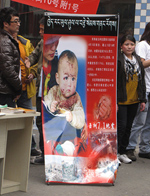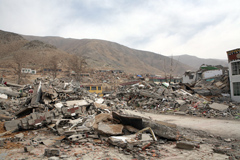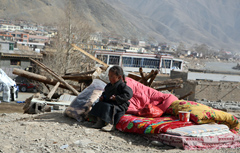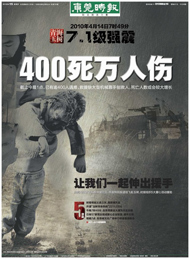
Talking Points
April 14
- 28, 2010
Nearly
1,800 people died in the quake that hit Yushu Tibetan Autonomous Prefecture
|
|
|
Tibetan
students from |
榆树藏族自治州
in China’s southern Qinghai province on April 14. Many thousands were
injured and an estimated 100,000 are homeless. Our sympathies are with the
people of Yushu and we cheer those working hard to
assist them. A partial list of organizations soliciting funds to aid Yushu is below.
The death toll might have been greater but for the fact that the 7:49 am quake
struck well before the start of the work or school day. Clocks in
|
|
|
Chinese authorities quickly dispatched large numbers of rescue
and relief workers, machinery, and supplies. The challenges are many,
including the altitude (Yushu is 4,000 meters (13,125
feet) above sea level), below freezing nighttime temperatures, and language
problems. Almost all (97%) of Yushu’s roughly 300,000
residents are Tibetan. The government reported it was bringing in 500
translators to help.
Quickly and effectively responding to such emergencies has become a priority
for
Ethnic unrest broke out in Yushu and in many other
places on the Tibetan plateau in 2008. There have been no reports of violence
between Tibetans and others in the aftermath of the earthquake, but some
foreign news organizations report that suspicions and tensions remain. The New
York Times described an instance where an army crew, which had given up
searching, pushed a group of monks aside so that the soldiers could be filmed
rescuing a trapped girl. Monks have handled the cremation of the dead. People`s
Daily reported Friday the mobilization of religious and cultural
affairs officials to address damage to temples and hardships imposed on monks
and others. 700 year old
The official Xinhua news site for Yushu
prefecture has not been updated since August 2009 (and even includes links
to MSN and Google). It listed Jia Yingzhong,
a Han who had been assigned to Yushu in 2000, as the
prefecture’s party secretary. A Tibetan is the prefecture head, though the site
only gives his Chinese name, Wang Yuhu 王玉虎. Yushu got a brand new
government website earlier today. Many of the links don’t yet work, but the
presence of top leaders and rescue teams is highlighted in the banner.
|
|
The South China Morning Post reported that
|
|
|
|
See the web version of Talking Points for 7 more front pages. |
|
International
news organizations have also sent reporters and camera crews to Yushu, though some have thus far elected to cover the
tragedy and responses to it from
These choices and the hard work of carrying them out are an important part
of the new
|
|
|
Photo by Jim Laurie, then of ABC News. |
USC US-China Institute documentary Assignment: China.
The documentary looks at how correspondents for American news organizations
sought to bring
There are many China-focused events and exhibitions across
We always appreciate hearing from you. Please write to us at uschina@usc.edu.
Best wishes,
The USC US-China Institute
china.usc.edu
Write to us at uschina@usc.edu
Subscribe to Talking Points at china.usc.edu/subscribe.aspx
Support the USC US-China Institute with your tax deductible gift at giveto.usc.edu/
Earthquake Relief
Support for Yushu relief has come from many
organizations and government agencies. Here are three organizations accepting
donations specifically for Yushu relief:
United
States Fund for UNICEF
Red Cross
Society of China
Direct Relief International






